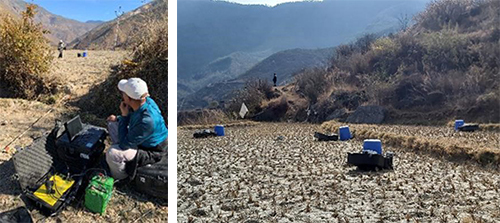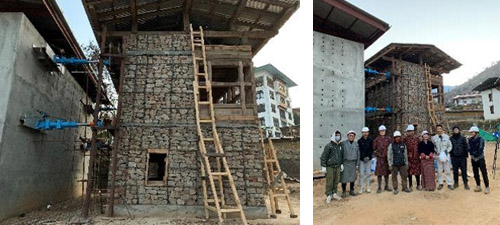Project News
2021-12-31
Monthly Report for December 2021
Microtremor measurement in Issun, Pilot site
The Department of Geology and Mines (DGM), the Ministry of Economic Affairs has been conducting microtremor survey in Issuna Gewog (sub-district), Paro Dzongkha (district) since 13th December 2021. Issuna is designated as a pilot site in our project as an area where rammed earth buildings are gathered. Areas are divided by a 100m square grid, and microtremor observations are performed on each grid. They are proceeding with observations according to the terrain while using the Spatial Auto-Correlation (SPAC) method and Multi-channel Analysis of Surface Waves (MASW) method together. The microtremor observation data is used to create a seismic hazard map as well as to create a risk map. For the risk map, the area having the residential area will be observed in detail. The observed data is shared with Japanese researchers, and the survey is carried out with advice from the Japanese team. The observation is leaded by Ms. Nityam, who returned from JICA long term training in October 2021. Through this observation, it is expected that she will be able to transfer technology to her colleague counterparts and learn efficient observation methods.
 MASW measurement (left), SPAC measurement (right)
MASW measurement (left), SPAC measurement (right)
Photo courtesy of DGM
Held loading test of real scale specimen
On December 28, a loading for a full scaled building specimen was conducted at the Department of Culture (DOC), the Ministry of Home and Cultural Affairs. This test specimen is a two-story masonry building constructed with the budget of DOC. It is a characteristic specimen that makes a wall by stacking gabions filled with stones. Gabion is a building material that can also be obtained locally in Bhutan. In the experiment, the amount of deformation was measured by pushing the ceiling of the ground floor and the roof floor with a horizontal jack. We were able to confirm that the deformation performance was greater than that of the conventional full-scale specimens (rammed earth / stone masonry houses by traditional construction method).
This experiment was conducted while Japanese researchers could not travel, and the counterparts did everything from preparation to loading by themselves with Japanese remote guidance. From this experience, the skills and knowledges will be further improved, and it seems that the next experiment will be able to be carried out more smoothly.
 State of Loading (Left), Members of Experiment (Right)
State of Loading (Left), Members of Experiment (Right)
Photo courtesy of DOC
The full-scale experiment was introduced on Bhutan Broadcasting service(BBS).
The state of the full-scale experiment conducted by Department of Culture (DOC) on December 28, 2021 was introduced on the Bhutan Broadcasting Service (BBS). The following articles and Link are introduced with photos.
Situated in the young Himalayan range, Bhutan is prone to earthquakes. And building earthquake-resilient structures are therefore crucial. To test the strength of the stone masonry structures to earthquake, the Department of Culture in collaboration with Japan International Cooperation Agency (JICA) conducted a full-scale test of the building yesterday. The test will check the effectiveness of the materials used in strengthening the building.
The full-scale test was conducted on a replica of the stone masonry building constructed in the department of culture. The building is strengthened by using materials that are locally produced and easily available in the local market.
"So, through this test we will check how effective these reinforcing measures are and how much it has improved the seismic capacity of the building. Moreover, from this test we will be able to understand the failures pattern of the stone masonry building," said Phuntsho Wangmo (PhD), deputy executive engineer of the department of culture.
The test is expected to formulate seismic guidelines for masonry buildings at the end of the project in 2023.
"After the test, we will come to know how much it has improved the strength of the building. So, in case if it has improved then we will be recommending this kind of reinforcing measure and at the end of the project we will be developing a guideline specifying a different reinforcing measure where people can choose," said Phuntsho Wangmo.
The five-year project is expected to improve the earthquake resistance of structures, reduce life and property loss, improve general understanding of hazards and develop disaster reduction technology in the country.
Choni Dema
Edited by Sonam Pem
- About JICA
- News & Features
- Countries & Regions
- Our Work
- Thematic Issues
- Types of Assistance
- Partnerships with Other Development Partners
- Climate Change / Environmental and Social Considerations
- Evaluations
- Compliance and Anti-corruption
- Science and Technology Cooperation on Global Issues
- Research
- JICA Development Studies Program / JICA Chair
- Support for the Acceptance of Foreign HRs / Multicultural and Inclusive Community
- Publications
- Investor Relations
